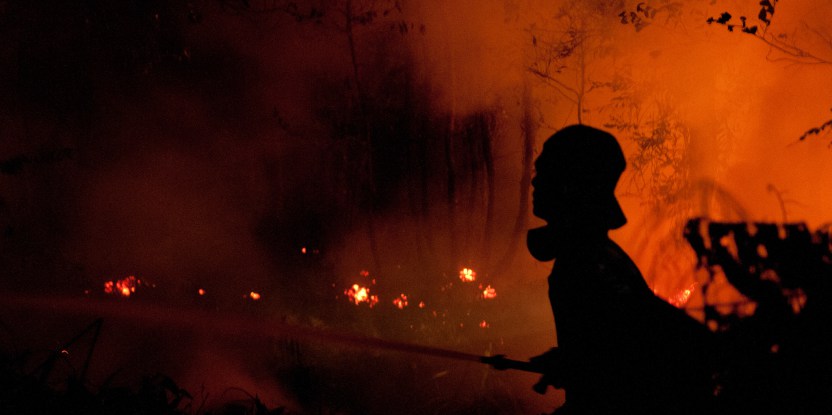
Editor’s Note: Forest conservation will be a theme of discussion at the upcoming Forests Asia Summit, 5-6 May in Jakarta, Indonesia. At the Summit, panelists will examine the complex governance of land and forest resources in Southeast Asia and explore ways to shape institutions, decision-making processes and rules so that they encourage sustainability in the landscape. Read more here.
BOGOR, Indonesia — Conservation programs must be better able to respond to the growing and often “complex” challenges associated with preserving the world’s forests and protecting livelihoods by looking to other sectors, such as the military, for new and innovative solutions, according to a recent report.
“Looking at complex systems and their associated ‘wicked problems’ has been a focus of research in various fields including mathematics, computing, psychology, knowledge management, military studies and business studies,” said Edward Game, conservation planning specialist for The Nature Conservancy and lead author of the paper Conservation in a wicked complex world: Challenges and solutions.
“The challenges that complexity pose for military engagement are often similar to those that arise in conservation,” he said. “Both sectors operate within very difficult environments yet often fail to get the best outcome because of standardized management practices that hamper effective decision-making and fail to encourage more innovative solutions.”
The study, co-authored by two senior associates with the Center for International Forestry Research (CIFOR), revealed that despite increasing recognition in the conservation sector about the complexities of balancing forest protection while limiting negative impacts on livelihoods, current conservation management systems and related practices are much better suited to operating within “simpler” systems.
“Like most conservation practitioners and scientists, we tackle problems as if they were an engineering problem, with clear cause-and-effect relationships, and the need to find the ‘best’ intervention,” Game said.
As such, current management systems are not always suited to dealing with the vast majority of global conservation challenges that happen within complex social-environmental systems, he added.
The difficulty is that many of these so-called “wicked” problems lack clear solutions because each problem is inter-linked and therefore difficult to isolate, argues the report.
Traditional armies have learned lessons from this, but conservation has not yet sufficiently caught up
For example, agricultural intensification — increasing crop production without expanding land area — is often seen as a way of protecting forests and biodiversity while at the same time improving livelihoods and food security, but fertilizers used to increase crop production can also present a threat to biodiversity.
Working effectively in complex systems therefore requires a “redesign of how we interact with them,” argues Game, and the first step is recognizing the limitations of current conservation management systems that often employ a one-size-fits-all approach, rely too heavily on ‘expert’ opinion and use standardized planning and implementation methods that rarely take into account the value of new approaches.
“At the moment, current management systems depend on a much clearer view of success or failure than is realistically possible, and funding and institutional structures make it challenging for creative local solutions to flourish.”
MILITARY APPROACH
Conservation organizations therefore focus far too much on selling and implementing the approaches or strategies they are using, rather than on what they are ultimately trying to achieve, Game said, adding that innovations in the military could serve as sound models upon which to base conservation methods.
“There are many parallels between conservation management and decision-making in warfare,” said Erik Meijaard, one of the report’s authors.
“There are especially useful insights from asymmetric warfare strategies, such as those used by guerrilla groups, which like conservation tend to engage a much more powerful enemy by strategically picking battles and ensuring they maintain public support.”
“Traditional armies have learned lessons from this, but conservation has not yet sufficiently caught up.”
For example, the hierarchical nature of the U.S. military has been restructured in order to support more decentralized decision-making processes. Rather than relying on a central intelligence body, the military has boosted the capacity of local units to better analyze data from those closest to the action in order to feed into their overall strategies. The militaries of the UK and Israel have also found distributed leadership effective by establishing clear mission objectives in senior ranks, and devolving tactical decisions to local commanders on the ground.
Not only has the “bottom up” approach enabled a more rapid response to complex military challenges but has provided local leaders with the confidence to explore novel solutions rather than worry about compliance with best practice, argues the report.
As a result, for conservation some solutions to complex problems could be found in distributing leadership and taking into account a wide diversity of skills and opinions in the workforce. In particular there is a need to challenge reinforced ideas about what constitutes “best practice” within the sector in order to foster creatively, diversity and innovation.
“We need to get away from our very entrenched view of conservation expertise, as well as being more transparent about the trade-offs that are inevitably associated with any conservation solution. I would like to see us stop using the terms ‘adaptive management’ and ‘win-win solution’ so flippantly and for people at all levels to feel like they can contribute new ideas,” Game said.
There is still a long way in challenging current conservation practices, argues Game, who he is quick to stress that with “wicked problems” there are no easy or “right” solutions.
“We are not saying that current conservation practices do not have a place and neither are we suggesting that the military are employing the ‘right’ tactics or that concepts from other fields will solve all our problems, however it does broaden our range of options and helps us to explore the different opportunities out there that can lead to better outcomes.”
For more information on the topics discussed in this article, please contact Terry Sunderland at t.sunderland@cifor.org
We want you to share Forests News content, which is licensed under Creative Commons Attribution-NonCommercial-ShareAlike 4.0 International (CC BY-NC-SA 4.0). This means you are free to redistribute our material for non-commercial purposes. All we ask is that you give Forests News appropriate credit and link to the original Forests News content, indicate if changes were made, and distribute your contributions under the same Creative Commons license. You must notify Forests News if you repost, reprint or reuse our materials by contacting forestsnews@cifor-icraf.org.

